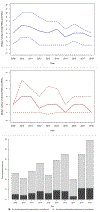US Food and Drug Administration utilization of postmarketing requirements and postmarketing commitments, 2009-2018
- PMID: 33863236
- PMCID: PMC8292154
- DOI: 10.1177/17407745211005044
US Food and Drug Administration utilization of postmarketing requirements and postmarketing commitments, 2009-2018
Abstract
Background/aims: The US Food and Drug Administration outlines clinical studies as postmarketing requirements and commitments to be fulfilled following approval of new drugs and biologics ("therapeutics"). Regulators have increasingly emphasized lifecycle evaluation of approved therapeutics, and postmarketing studies are intended to advance our understanding of therapeutic safety and efficacy. However, little is known about the indications that clinical studies outlined in postmarketing requirements and commitments investigate, including whether they are intended to generate evidence for approved or other clinical indications. Therefore, we characterized US Food and Drug Administration postmarketing requirements and commitments for new therapeutics approved from 2009 to 2018.
Methods: We conducted a cross-sectional study of all novel therapeutics, including small-molecule drugs and biologics, receiving original US Food and Drug Administration approval from 2009 to 2018, using approval letters accessed through the Drug@FDA database. Outcomes included the number and characteristics of US Food and Drug Administration postmarketing requirements and commitments for new therapeutics at original approval, including the types of studies outlined, the indications to be investigated, and the clinical evidence to be generated.
Results: From 2009 to 2018, the US Food and Drug Administration approved 343 new therapeutics with 1978 postmarketing requirements and commitments. Overall, 750 (37.9%) postmarketing requirements and commitments outlined clinical studies. For 71 of 343 (20.7%) therapeutics, no postmarketing requirements or commitments for clinical studies were outlined, while at least 1 was outlined for 272 (79.3%; median 2 (interquartile range: 1-4)). Among these 272 therapeutics, the number of postmarketing requirements and commitments for clinical studies per therapeutic did not change from 2009 (median: 2 (interquartile range: 1-4)) to 2018 (median: 2 (interquartile range: 1-3)). Among the 750 postmarketing requirements and commitments for clinical studies, 448 (59.7%) outlined new prospective cohort studies, registries, or clinical trials, while the remainder outlined retrospective studies, secondary analyses, or completion of ongoing studies. Although 455 (60.7%) clinical studies investigated only original approved therapeutic indications, 123 (16.4%) enrolled from an expansion of the approved disease population and 61 (8.1%) investigated diseases unrelated to approved indications.
Conclusions: The US Food and Drug Administration approves most new therapeutics with at least 1 postmarketing requirement or commitment for a clinical study, and outlines investigations of safety or efficacy for both approved and unapproved indications. The median number of 2 clinical studies outlined has remained relatively constant over the last decade. Given increasing emphasis by the US Food and Drug Administration on faster approval and lifecycle evaluation of therapeutics, these findings suggest that more postmarketing requirements and commitments may be necessary to address gaps in the clinical evidence available for therapeutics at approval.
Keywords: The US Food and Drug Administration; clinical evidence; clinical trials; pharmaceutical regulation; postmarketing commitments; postmarketing requirements.
Figures

References
-
- United States Food and Drug Administration (FDA). Guidance for Industry: Providing Clinical Evidence of Effectiveness for Human Drug and Biological Products, https://www.fda.gov/downloads/drugs/guidancecomplianceregulatoryinformat... (1998, accessed 29 June 2020).
-
- Psaty BM, Meslin EM, Breckenridge A. A Lifecycle Approach to the Evaluation of FDA Approval Methods and Regulatory Actions: Opportunities Provided by a New IOM Report. JAMA 2012; 307: 2491–2492. - PubMed
Publication types
MeSH terms
Grants and funding
LinkOut - more resources
Full Text Sources
Other Literature Sources

